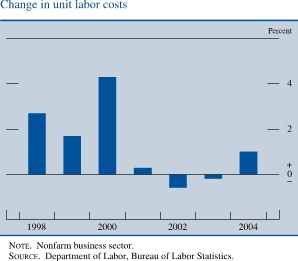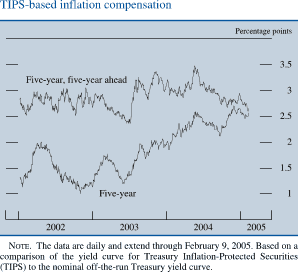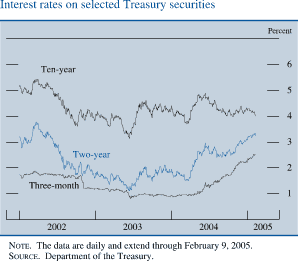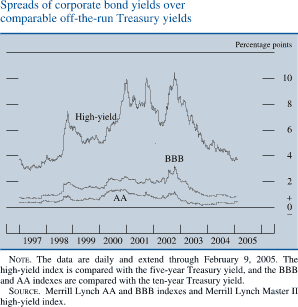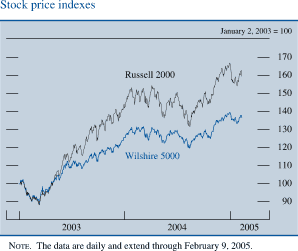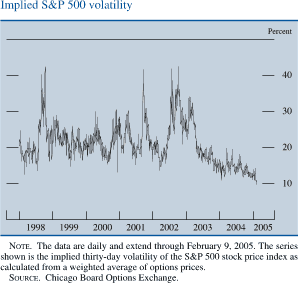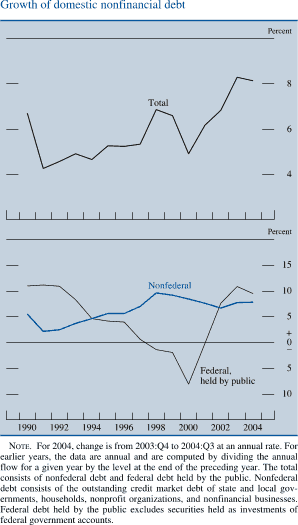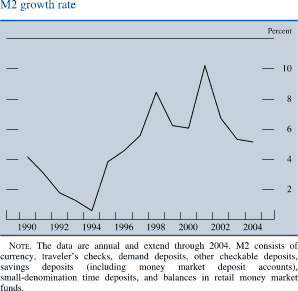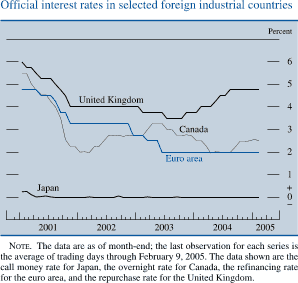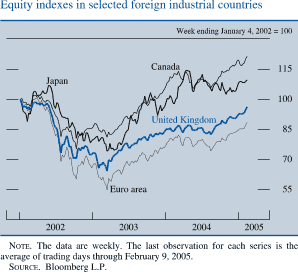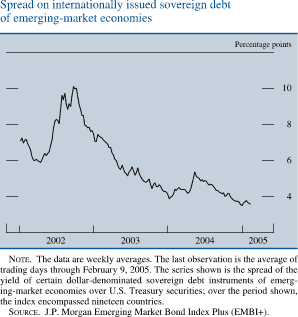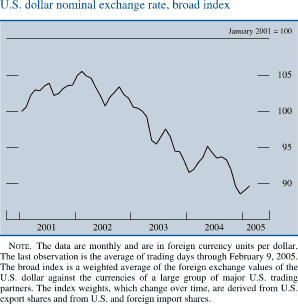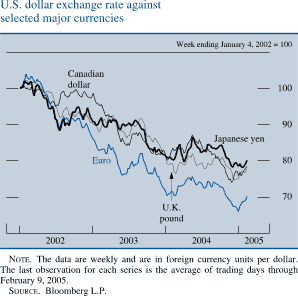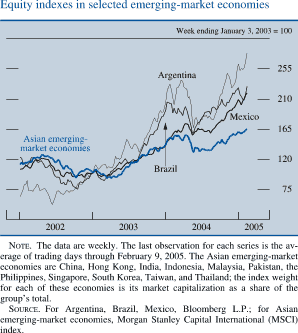
Monetary Policy Report submitted to the Congress on February 16, 2005, pursuant to section 2B of the Federal Reserve Act
Section 2
ECONOMIC AND FINANCIAL DEVELOPMENTS IN 2004 AND EARLY 2005
The economy proved to be sufficiently resilient to maintain solid growth and moderate core inflation in 2004 even as higher oil prices drained consumers' purchasing power and boosted firms' costs. Real GDP rose 3-3/4 percent last year after having increased 4-1/2 percent in 2003. Activity was supported by continued robust advances in household spending. In addition, capital spending by businesses increased notably. Labor market conditions improved significantly, though at an uneven pace over the course of the year. Private payrolls, which turned up in late 2003, rose 170,000 per month last year, on average, and the unemployment rate declined below 5-1/2 percent by year-end and to 5-1/4 percent in January 2005--the lowest rates since 2001.

Consumer price inflation was driven higher last year by the sharp rise in energy prices. Although core consumer price inflation moved up somewhat from unusually low levels recorded in 2003, it remained well contained. Price increases were restrained by continuing, though diminishing, slack in labor and product markets, which tended to offset the effects of higher energy and commodity prices, as well as the weaker dollar, on firms' overall costs. In addition, solid productivity gains implied that unit labor costs rose only modestly, even if up from the declines in the preceding two years. The decline in crude oil prices, on balance, since October points to some easing of cost pressures on firms from that source in the period ahead.
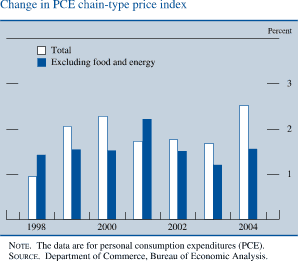
Several forces likely contributed to last year's impressive economic performance in the face of the sizable adverse oil shock. The growth of real output continued to be undergirded by gains in structural labor productivity. Moreover, fiscal policy remained stimulative last year through the combination of the lagged effect of earlier cuts in personal tax rates, the rise in defense spending, and perhaps also the partial-expensing tax incentives for business investment. Monetary policy was highly accommodative in the early part of the year and remained accommodative, though progressively less so throughout the year, and credit remained readily available at favorable terms. Consumer demand was also boosted by the strong increases in asset values during the past two years.
Financial conditions remained stimulative last year even as market participants revised up their expectations for the near-term path of monetary policy. Interest rates on longer-term Treasury securities remained low, risk spreads on corporate bonds narrowed, and commercial banks eased terms and standards on business loans. In this environment, household debt again increased briskly. The borrowing needs of nonfinancial businesses were damped by their strong cash flows. Equity values rose, especially toward the end of the year. At the same time, the exchange value of the dollar declined, on net, over the year as market participants apparently focused on the financing implications of the large and growing U.S. current account deficit.
The Household Sector
Consumer Spending
Consumer spending grew substantially last year. Personal consumption expenditures (PCE) advanced nearly 4 percent in real terms, about the same as the increase in 2003. Sales of new motor vehicles remained brisk, on average, at 16-3/4 million units. Excluding motor vehicles, consumer spending on most categories of durable and nondurable goods rose rapidly, as gains in real expenditures for food and clothing both exceeded 5 percent; however, spending on computing equipment increased less in 2004 than in preceding years, and consumers responded to the high cost of gasoline and heating fuel by cutting back on real spending for these items. Real outlays for services also increased rapidly last year, and medical services posted especially large gains.
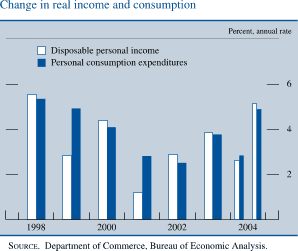
Real disposable personal income (DPI) rose nearly 4 percent last year, but this figure is exaggerated by Microsoft's $32 billion special dividend payment in December (the bulk of which is estimated to have accrued to U.S. households). If this one-time event is excluded from the calculation, real DPI rose only 2-3/4 percent in 2004, well below the increase posted in 2003. Faster job growth helped to support increases in households' incomes last year in nominal terms, and the Jobs and Growth Tax Relief Reconciliation Act of 2003 (JGTRRA), which brought lower personal tax rates forward into 2003, led to larger refunds and smaller final payments in the spring of 2004. However, real income gains were held down, as higher oil prices siphoned off household purchasing power.
With the growth of real consumption spending outpacing that of real income through most of last year, the personal saving rate moved lower, from 1-1/2 percent, on average, in 2003 to only 1/2 percent in the third quarter of last year. (The fourth-quarter surge in income associated with the Microsoft dividend payments pushed the saving rate back up to 1-1/4 percent, but this increase will likely be reversed early this year as dividend income falls back. Because the company's share price declined in step with the dividend payouts, the dividends had no effect on shareholders' overall financial resources and so probably had little effect on consumption.)
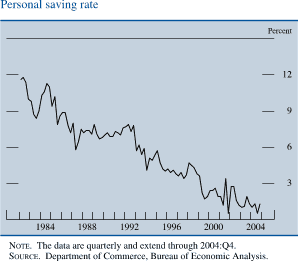
Low interest rates were one factor that helped to support consumption growth--especially for durable goods--despite comparatively slow gains in real income. Higher household wealth was also an important force that propelled consumer spending last year. According to the Federal Reserve's flow of funds accounts, the ratio of household net worth to disposable income rose sharply in 2003, as corporate equity values rebounded and home prices continued to rise. Moreover, although equity values were little changed, on net, through much of 2004 before rising notably in the final quarter, home prices continued to rise throughout the year, and the wealth-to-income ratio moved up further; by the third quarter (the most recent period for which the complete wealth data are available), the ratio had reversed nearly half its decline since the stock market peak in 2000. Because wealth feeds through into household spending over a period of several quarters, the wealth increases in both 2003 and 2004 were important in supporting consumer spending last year. The rise in house prices, together with continued low interest rates, also led consumers to extract additional equity from their homes, in particular through home equity loans. Such actions provided many households with a readily available and relatively low-cost source of funds for financing consumption.
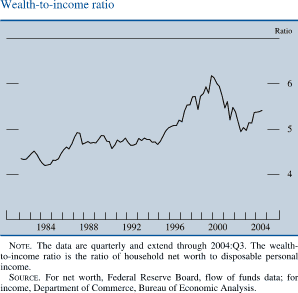
Consumer confidence, which had improved in 2003, remained at generally favorable levels last year, according to surveys by both the Michigan Survey Research Center (SRC) and the Conference Board. Confidence tended to dip at times during the year when energy prices were moving up most rapidly, but it recovered soon after those episodes.

Residential Investment
Residential investment remained robust last year. Real expenditures increased 5-3/4 percent in 2004--the third straight year of strong gains. Demand for housing was influenced by the same factors that affected household spending more generally, but it was especially supported by nominal mortgage interest rates that have remained near their lowest levels since the late 1960s. Rates on thirty-year fixed-rate mortgages fluctuated between about 5-1/2 percent and 6-1/4 percent over the past two years; they edged up to the high end of that range during the spring but dropped back to under 6 percent by the end of summer and now stand below 5-3/4 percent.

In the single-family sector, housing starts amounted to 1.6 million units last year, a rate faster than the already rapid pace of 1.5 million units started in 2003. In the multifamily sector, starts totaled a solid 350,000 units last year, a figure in line with that of the preceding several years. Sales of both new and existing single-family homes hit new highs last year, and home prices moved up sharply. The repeat-transactions price index for existing homes (limited to purchase transactions only), which is published by the Office of Federal Housing Enterprise Oversight, climbed more than 10 percent over the four quarters ending in the third quarter of last year (the latest quarter for which data are available) and is up a cumulative 65 percent since 1997, when it started to rise notably more rapidly than overall inflation. These price increases have also outstripped by a wide margin the increases in household incomes and rents. Another nationwide price index, the Census Bureau's constant-quality price index for new homes, rose only 6-3/4 percent last year. Because this index does not adjust for the location of new homes within metropolitan areas, and because new homes constitute only a small fraction of the overall housing stock, this index is probably a less reliable indicator of overall home values than is the repeat-transactions index.


Household Finance
Household debt is estimated to have increased about 9-3/4 percent in 2004, a touch less than in the previous year. Mortgage debt again paced this advance. The brisk expansion of mortgages reflected continued strong activity in housing markets and rising house prices. However, the growth rate of mortgage debt did not quite match that registered in 2003. Refinancing activity fell off sharply last year, as the pool of outstanding mortgages with interest rates above current market rates shrank considerably. Mortgages with adjustable interest rates, including hybrids that feature both fixed and adjustable interest rate components, were increasingly popular in 2004. Consumer credit continued to expand at a moderate pace by historical standards, restrained in part by the substitution of other forms of debt, such as home equity loans. Higher interest rates on some consumer loans and credit cards in the second half of 2004 may have also damped the growth of consumer credit.
Relatively low interest rates and further gains in disposable personal income limited pressures on household balance sheets in 2004. Measures of aggregate household financial obligations and debt service, which capture pre-committed expenditures relative to disposable income, were little changed last year, on balance, though they remained high by historical standards. Nevertheless, measures of household credit quality either held steady or improved during the course of the year. The latest available data indicate that delinquency rates on credit card loans, consumer loans, and residential mortgages at commercial banks declined, while those on auto loans at captive finance companies were about unchanged at a low level. Household bankruptcy filings ran below the elevated levels of 2003, although they stayed generally above the rates posted in earlier years.

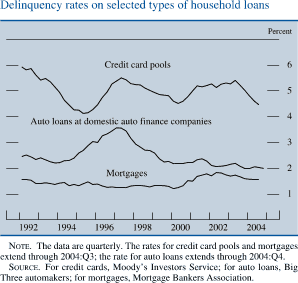
The Business Sector
Fixed Investment
Business fixed investment rose robustly for a second consecutive year in 2004. Real spending on equipment and software (E&S) increased 13-1/2 percent, about as much as in 2003, as firms' final sales continued to increase, profits and cash flow rose further, and many businesses reported a need to replace or upgrade existing equipment and software. Although many firms had little need to seek outside financing given their flush cash situation, those that did generally found financial markets to be receptive--interest rates remained low and other terms and conditions stayed relatively favorable. The partial-expensing tax incentives, which covered new equipment and software installed by the end of 2004, boosted profits and cash flow and may have also stimulated some investment spending.

Increases in E&S spending were fairly widespread across categories of capital goods. Spending on high-technology equipment increased 15-1/2 percent last year after having risen 19 percent in 2003; these gains followed two years of declines. Although the pattern of spending was uneven over the four quarters of 2004, for the year as a whole, business outlays for computing equipment rose 25 percent in real terms, while spending on software and communications equipment posted increases of 13 percent and 10 percent respectively. Outside of the high-tech sector, business spending on aircraft moved lower for the third consecutive year, as airlines continued to struggle with a highly competitive market environment and high fuel prices. In contrast, business outlays on motor vehicles rose substantially last year, with the demand for trucks exceptionally strong. Investment in equipment other than high-tech and transportation goods--a category that includes industrial machinery and a wide range of other types of equipment--moved up 11 percent last year, the most in more than ten years.
In contrast to the rebound in equipment spending, real outlays in the nonresidential construction sector were about unchanged for a second year in 2004 and have yet to recover from their sharp downturn during 2001 and 2002. In the office sector, where construction increased rapidly in the late 1990s, spending has remained especially weak; vacancy rates for these properties, although down a touch over the past year, are still quite elevated. Construction of industrial buildings has also remained low as a result of high vacancy rates. In contrast, demand for new retail and wholesale properties has been firmer, reportedly a reflection of the steady increases in consumer spending, and outlays for these types of buildings moved higher last year. In addition, investment in the drilling and mining sector rose last year in response to high prices for natural gas.
Inventory Investment
Businesses added appreciably to inventories last year for the first time since running down their holdings sharply in 2001. As economic activity strengthened during 2002 and 2003, many businesses chose to operate with inventories that were increasingly lean relative to sales. In 2004, when stocks had become quite spare--even after taking into account the ongoing improvements in inventory management that have allowed firms to economize on stockholding--and businesses had apparently grown more confident in the durability of the recovery, businesses accumulated $45 billion of inventories (in real terms), according to preliminary data. The step-up in the pace of stockbuilding contributed about 1/4 percentage point to GDP growth last year.

Corporate Profits and Business Finance
Strong growth of corporate profits again allowed many firms to finance capital spending with internal funds last year. As a result, nonfinancial business debt rose at only a moderate pace. Net equity issuance dropped further into negative territory in 2004, and on balance nonfinancial corporations are estimated to have raised no net funds in credit and equity markets. However, short-term business debt, including commercial paper and commercial and industrial (C&I) loans, expanded last year after three years of contraction, and commercial mortgage debt continued to increase rapidly. The credit quality of businesses remained strong.
Corporate profits held up well in 2004 after surging in the previous year. The ratio of before-tax profits of nonfinancial corporations to that sector's gross value added increased for a second consecutive year. In the fourth quarter of 2004, operating earnings per share for S&P 500 firms were nearly 20 percent above their level four quarters earlier. Analysts' earnings forecasts began to moderate somewhat in the second half of 2004 after several months of strong upward revisions.
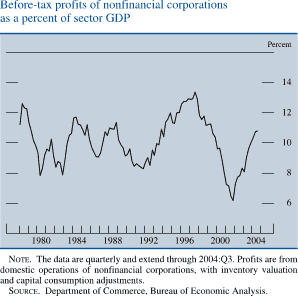
In equity markets, net issuance of shares by nonfinancial firms turned more negative in 2004. Although initial public offerings rebounded from the sluggish pace of the past two years, ample profits and sizable cash holdings helped boost share retirements from mergers and repurchases.
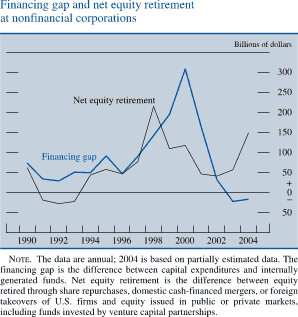
Net corporate bond issuance was sluggish in 2004, as firms evidently relied heavily on their considerable profits to fund investment in fixed capital and inventories. The timing of gross bond issuance was influenced by interest rate movements during the year, as firms took advantage of occasional dips in longer-term yields to issue bonds. Firms reportedly used a large portion of the proceeds to pay down existing debt, although some companies used the funds raised in the bond market to repurchase equity shares or to finance mergers.

Short-term business borrowing revived in 2004 after a prolonged contraction. Commercial paper outstanding turned up in the first half of the year, although it flattened out over the second half. Business loans at banks rebounded over the course of last year. According to results from the Federal Reserve's Senior Loan Officer Opinion Survey on Bank Lending Practices, commercial banks eased terms and standards on business loans during the course of 2004 in response to the improved economic outlook and to increased competition from other banks and nonbank lenders. Survey responses also indicated an increase in demand for C&I loans that reflected firms' need to fund rising accounts receivable, inventories, capital expenditures, and merger activity. Concerns over loan quality seemed to diminish further in 2004, as spreads on leveraged deals in the syndicated loan market edged down from already low levels.

Corporate credit quality remained solid in 2004 amid strong earnings, low interest rates, and a further buildup of already substantial cash positions on firms' balance sheets. The delinquency rate on C&I loans declined further, and the twelve-month trailing default rate on corporate bonds fell to historically low levels before edging up late in the year. Net upgrades of bonds by Moody's Investor Service for both investment- and speculative-grade nonfinancial firms increased last year.
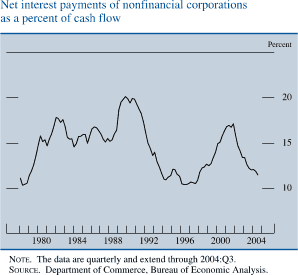

The stock of commercial mortgage debt outstanding grew at a rapid pace in 2004. Some firms reportedly continued to find mortgages an attractive source of long-term funding. The expansion of commercial mortgage credit helped propel issuance of commercial-mortgage-backed securities (CMBS) to near-record levels. Delinquency rates on commercial mortgages on the books of banks and insurance companies remained low throughout the year, and those on loans backing mortgage securities fell. Considerable gains in commercial real estate prices increased owners' equity and largely kept pace with the sizable increase in mortgage debt obligations. Yield spreads of CMBS over comparable Treasury securities remained moderate.
The Government Sector
Federal Government
The federal budget position deteriorated slightly further in 2004, as spending increases and further tax reductions offset the effects of stronger economic growth on revenues. The unified budget deficit widened from $378 billion in fiscal 2003 to $412 billion in fiscal 2004. As a share of GDP, the federal unified deficit stood close to 3-1/2 percent in both years. Receipts increased 5-1/2 percent in fiscal 2004 after two years of declines. Corporate receipts surged more than 40 percent, or $58 billion, reflecting the improvement in corporate profits; individual tax receipts--restrained by JGTRRA, which pulled forward reductions of personal tax rates that had been scheduled for the second half of the decade--rose only about 2 percent. Overall federal receipts increased less rapidly than nominal GDP, and the ratio of receipts to GDP edged down to 16-1/4 percent, the lowest level in more than forty years.
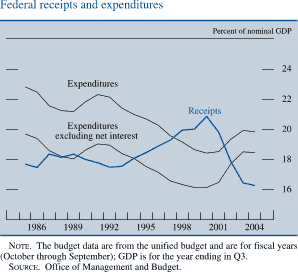
Meanwhile, nominal federal outlays increased about 6 percent in fiscal 2004. Spending for national defense increased especially sharply, but spending also increased notably for Medicare and Medicaid. Debt service costs, which fell sharply from 1997 through 2003 as a result of reduced debt and declining interest rates, edged higher last year. Federal government purchases of goods and services--the part of spending that is counted in GDP--rose about 4 percent in real terms in 2004 after larger increases in the preceding two years. (Government spending on items such as interest payments and transfers is excluded from GDP because these items do not constitute a direct purchase of final production.)

Regarding legislative initiatives, two new tax bills were enacted in the fall of 2004. First, the Working Families Tax Relief Act extended through 2010 a variety of personal tax reductions that had previously been set to expire earlier. Second, the American Jobs Creation Act replaced the exclusion of extraterritorial income (which the World Trade Organization had declared an illegal export subsidy) with numerous other tax reductions for domestic manufacturers and U.S. multinationals. The first bill is expected to have a ten-year budget cost of around $150 billion, while the second bill was scored as being revenue neutral. As for federal spending in fiscal 2005, the regular appropriations bills provided for sizable increases in spending on defense and homeland security and for modest increases in nondefense discretionary expenditures. In addition, emergency legislation passed in the autumn provided disaster aid for victims of hurricanes and for ranchers and farmers affected by drought conditions.
The recent sizable deficits in the unified budget mean that the federal government, which had been contributing to the pool of national saving from 1997 through 2000, has been drawing on that pool since 2001. Net federal saving--essentially the unified budget balance adjusted to the accounting practices of the national income and product accounts (NIPA)--dropped from positive 2 percent of GDP in 2000 to a level below negative 3 percent of GDP in 2003 and 2004. Personal saving moved lower over this period as well, while business net saving rose with the rebound in corporate profits. In all, net national saving edged up in 2004 but remained near its postwar lows. Because net national saving has fallen increasingly short of net domestic investment over the past several years, the inflow of foreign funds needed to finance that investment has risen. The growing inflow of foreign capital is mirrored in the widening of the nation's current account deficit. Over time, the low national saving rate could eventually slow the rise in living standards either by increasing the burden of servicing U.S. foreign debt or by impinging on domestic capital formation.
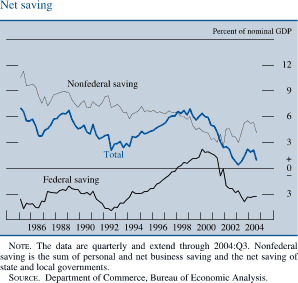
The growth rate of Treasury debt moderated slightly last year after increasing substantially in 2003. Nonetheless, federal debt held by the public as a percentage of GDP continued to edge higher over the course of 2004 and currently stands at about 36-1/2 percent. To help finance substantial budget deficits, the Treasury issued a considerable volume of bills as well as two-, three-, five-, and ten-year nominal notes. In addition, the Treasury expanded its borrowing program in 2004 by adding semiannual auctions of twenty-year inflation-protected bonds and five-year inflation-protected notes.
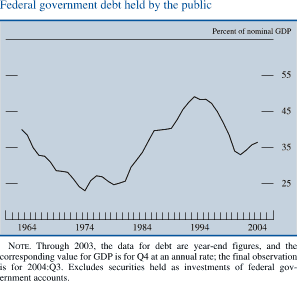
Various indicators suggested a continued strong appetite for Treasury securities among foreign investors last year. Indirect bidding at Treasury auctions, which includes bidding by the Federal Reserve Bank of New York on behalf of foreign official institutions, remained robust, and Treasury securities held in custody at the Federal Reserve Bank of New York on behalf of such institutions increased just over $200 billion in 2004. Also, data from the Treasury International Capital System showed a substantial increase in holdings of Treasury securities by foreign official and private investors, particularly those in Japan. The proportion of Treasury securities held by foreign investors is estimated to have risen to a record 43-1/2 percent by the third quarter of 2004.

Treasury debt reached its statutory ceiling late last year. To cope with the constraint, the Treasury temporarily resorted to accounting devices, suspended issuance of state and local government series securities, and postponed a four-week bill auction. In mid-November, Congress raised the debt ceiling from $7.4 trillion to $8.1 trillion, and the Treasury subsequently resumed normal financing operations.
State and Local Governments
Pressures on the budgets of state and local governments have eased as economic activity has strengthened. Tax receipts have been spurred by the increases in household income, consumer spending, and property values. As a result, many states seem to be on track to meet balanced budget requirements in the current fiscal year (which ends June 30 for all but a few states) without using as much borrowing or other extraordinary measures as in recent years. Nevertheless, a number of states still must deal with lingering fiscal problems, particularly depleted reserve funds, the expiration of temporary tax hikes, and rising Medicaid costs. In addition, several states still face serious structural imbalances in their budgets.
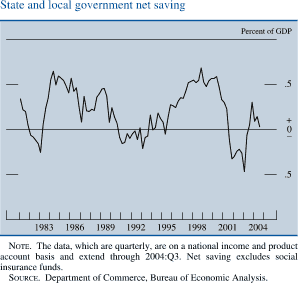
Real expenditures by state and local governments as measured in the NIPAs remained about flat for a second year in 2004. Real spending on current operations rose less than 1 percent last year, while real investment spending declined. However, even as they were holding the line on spending increases, states and localities were able to resume net hiring in 2004 after having left employment about unchanged in 2003.
Net issuance of debt by state and local governments edged down from the rapid pace set in 2003, as improved budget positions permitted some contraction in short-term debt. Advance refunding offerings were again strong during the year, as states and municipalities took advantage of low long-term interest rates and moderate credit spreads. Credit quality of tax-exempt borrowers improved in 2004. Rating upgrades of tax-exempt bonds outpaced downgrades, especially later in the year.
The External Sector
After narrowing in 2003, the U.S. current account deficit widened again last year and was $660 billion (annual rate), or 5.6 percent of GDP, in both the second and third quarters. Much of this widening reflected a considerable increase in the deficit on goods and services trade, as a marked rise in imports more than offset solid increases in exports. The trade deficit expanded from $500 billion during the fourth quarter of 2003 to more than $650 billion, on average, during the second half of 2004.
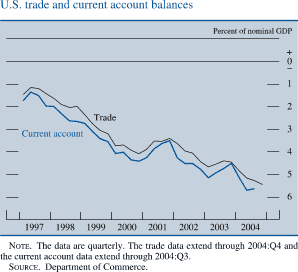
International Trade
Real exports of goods and services rose an estimated 5-1/2 percent in 2004 despite a deceleration in the fourth quarter. In the first half, exports were supported by the lagged effect of the fall in the dollar's value in 2003. Strong expansion of foreign economic activity also helped boost exports in the first half, but that stimulus diminished in the second half of the year when foreign growth slowed. For the year as a whole, exports of industrial supplies and capital goods posted solid growth. Exports to Canada, Mexico, and western Europe rose smartly in 2004, whereas exports to Japan were relatively weak. Real exports of services increased about 3-1/2 percent through 2004 as a whole.
After increasing at an annual rate of almost 6 percent in the first half of 2004, prices of exported goods moved up at just a 2-1/2 percent rate in the second half. This deceleration was due in large part to a reversal of the run-up in the prices of agricultural products that had occurred in late 2003 and early 2004. Better harvests last year returned prices of agricultural products to levels near those that had prevailed before the spike.
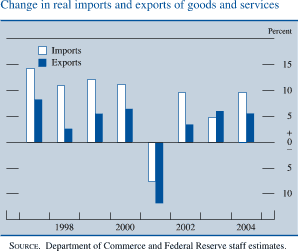
Solid growth in income in the United States spurred growth of real imports of 9-1/2 percent in 2004. The increase primarily reflected higher imports of goods that occurred despite a notable rise in their prices. Real oil imports expanded almost 10 percent in 2004. Imports of capital equipment increased throughout the year, but imports of consumer goods suffered a period of weakness through the middle of the year before rebounding in the fourth quarter. Imports of services moved up only 1-3/4 percent in 2004.
Prices of imported non-oil goods increased at an annual rate of just over 4 percent in the first half of 2004, but the pace slowed to 2 percent in the second half. This step-down largely reflected a deceleration in the prices of industrial supplies, driven by a leveling off of nonfuel commodity prices at the elevated levels reached in March. Declines in the prices of foods offset continued price increases for metals.
The spot price of West Texas intermediate (WTI) crude oil moved up during most of 2004 and surged temporarily to a record high of $55 per barrel in October. Since then, it has fluctuated somewhat below that peak but still at levels well above $33 per barrel, the price at which it started 2004. Oil prices were driven up by intensified concerns that oil supply would not keep pace with surprisingly strong global demand. Oil consumption in China grew nearly 15 percent in 2004, pushing that economy past Japan as the world's second-largest consumer. As oil prices rose, OPEC increased its oil production, diminishing the cartel's estimated spare capacity to historically low levels. Increased OPEC production damped particularly the rise in prices of heavier, more sulfurous grades of crude oil but had less effect on prices of lighter grades like WTI. Supply disruptions also played a role in the run-up of oil prices. In October, Hurricane Ivan extensively damaged oil and gas production facilities in the Gulf of Mexico, boosting the price of WTI relative to other grades of crude oil. Sabotage of production and distribution facilities in Iraq hindered oil exports from that country, which remain below pre-war levels. In Nigeria, ethnic violence and community protests shut down some production. Russian oil output, however, continued despite the breakup of Yukos, formerly Russia's largest oil company. Late in the year, oil prices declined from their October highs, as production recovered in the Gulf of Mexico and OPEC added new capacity. The price of the far-dated NYMEX oil futures contract (currently for delivery in December 2011) rose about $10 per barrel during 2004, possibly reflecting expectations of greater oil demand in Asian emerging-market economies. The far-dated futures contract averaged about $38 per barrel in January 2005, while the spot price of WTI averaged about $48 per barrel.


The Financial Account
In 2004, the U.S. current account deficit was financed once again largely by foreign purchases of U.S. bonds. Foreign official inflows picked up further last year and were especially strong in the first quarter, reflecting sizable bond purchases by Asian central banks. Private foreign purchases of U.S. bonds rebounded in 2004 from a slight decline in 2003, with especially large purchases coming late in the fourth quarter. In contrast, foreign demand for U.S. equities weakened further in 2004, although this also picked up late in the year. Net purchases of foreign securities by U.S. investors remained strong in 2004, with most of the strength coming in the second half of the year.

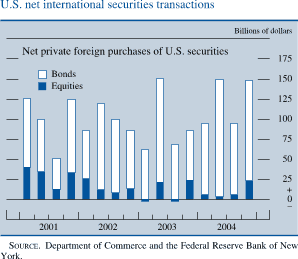
U.S. direct investment abroad continued at a strong pace, as reinvested earnings remained sizable. Direct investment into the United States rebounded in the first three quarters of 2004 from its anemic pace in 2003; global mergers and acquisitions revived, and reinvested earnings picked up. Overall, net direct investment outflows continued over the first three quarters of 2004 but at a lower pace than in 2003.
Net inflows of portfolio capital exceeded net outflows of direct investment and represented the financial counterpart to the U.S. current account deficit. These net financial inflows imply a further decline in the U.S. net international investment position, which began 2004 at a reported level of negative $2.4 trillion (22 percent of GDP).
The Labor Market
Employment and Unemployment
The labor market improved notably in 2004. Private payrolls, which began to post sustained increases in late 2003, rose an average of 170,000 per month last year. Progress was not steady over the course of the year, however. Employment growth stepped up sharply in the spring to a pace of almost 300,000 per month in March, April, and May; net hiring then dropped back to subpar rates of about 100,000 per month in June through September. In the four months since then, increases in private payrolls have averaged 165,000 per month.

The improved pace of hiring was widespread, as all major industry groups contributed to faster employment growth relative to that of the latter part of 2003. The largest gains were in professional and business services and health services. The construction sector also posted substantial gains. In the manufacturing sector--where employment had declined almost continuously since early 2000--payrolls increased in the spring when overall employment was rising sharply but were about unchanged, on net, over the second half of the year. Employment gains in retail trade and in food services were also brisk over the first half of the year but tapered off in the second half. Meanwhile, state and local governments added substantially to their payrolls last year, especially for education, but civilian employment in the federal government edged lower.
The unemployment rate fell from near 6 percent in late 2003 to less than 5-1/2 percent by late last year; joblessness fell further in January 2005, to 5-1/4 percent. The decline in the unemployment rate over the past year reflected both the pickup in hiring and a labor force participation rate that remained surprisingly low. From 2001 through 2003, the participation rate declined by more than would have been predicted on the basis of past relationships with indicators of labor demand, and in 2004, when the pace of hiring increased, the participation rate leveled off but failed to rise. These considerations suggest that there may be a persistent component to the recent softness in participation. However, participation had been quite strong through 2000, when the labor market was extremely tight, and the fact that participation turned down at the same time that labor demand weakened suggests that at least some of the recent low participation is cyclical. To the extent that some of this low participation proves to be transitory, the resumption of more-rapid labor force growth will limit the speed at which employment gains further push down the unemployment rate.

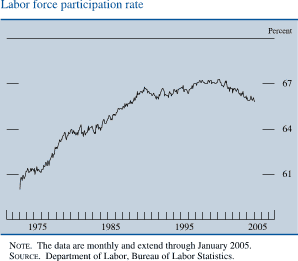
Productivity and Labor Costs
Labor productivity rose solidly again last year. Output per hour in the nonfarm business sector increased an estimated 2-1/2 percent over the year. This increase was somewhat below the outsized 4 percent average pace of increase from 2001 through 2003. Those earlier huge productivity gains were not associated with especially large accumulations of new capital equipment, as had been the case during the late 1990s; instead, to a large degree, the gains seem to have been related to more effective use of capital equipment that had been acquired earlier and to one-time organizational innovations induced by firms' earlier reluctance to commit to increased hiring. Still, last year's 2-1/2 percent increase in productivity was impressive by long-run standards: It was in line with the pace of the late 1990s and well above rates that had prevailed during the preceding two decades.
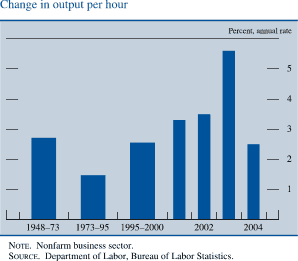
Increases in hourly labor compensation remained moderate last year. As measured by the employment cost index (ECI), which is based on a quarterly survey from the Bureau of Labor Statistics, hourly compensation in private nonfarm businesses increased 3-3/4 percent in 2004, a bit less than in 2003. An alternative measure is compensation per hour in the nonfarm business sector as derived from compensation data in the NIPAs. This measure of hourly compensation rose 3-1/2 percent last year, an increase similar to that in the ECI but substantially less than the 5-1/2 percent rise in 2003.
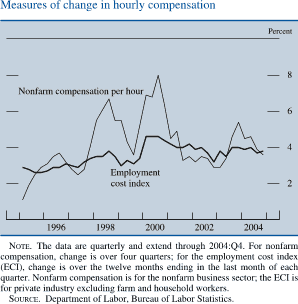
As has been the case for several years, the cost of employee benefits rose considerably more than did wages and salaries last year. The benefits component of the ECI increased nearly 7 percent, while the wages and salaries component posted a much more moderate 3 percent increase. The rise in hourly wages and salaries was about the same as increases in the preceding two years; although probably boosted by last year's higher rate of price inflation, wages were likely held down by the continued, though diminishing, labor market slack and also by employers' attempts to offset continued large increases in benefits costs. Health insurance costs continued to rise rapidly. As measured by the ECI, employers' costs of health insurance, which account for about 6 percent of overall compensation costs, rose 7 percent last year after having increased more than 10 percent per year in 2002 and 2003.
Prices
Overall consumer prices rose notably more in 2004 than they did in 2003, and the sharp increase in energy prices accounted for much of the step-up. The chain-type price index for personal consumption expenditures (PCE) rose 2-1/2 percent last year, compared with an increase of 1-3/4 percent in 2003. The increase in PCE prices excluding food and energy was considerably smaller--only 1-1/2 percent, up a little more than 1/4 percentage point from the increase in 2003. Inflation as measured by the market-based component of core PCE prices--which excludes a collection of erratic prices that are unobservable from market transactions and which the Bureau of Economic Analysis began to publish early last year--was in line with overall core PCE inflation last year. The core consumer price index (CPI) rose about 2 percent last year after having increased 1-1/4 percent in 2003. (The CPI differs from PCE prices in a number of respects, but one factor that boosted CPI inflation relative to PCE inflation last year was a difference in the way the two indexes measure the prices of medical services, especially physicians' services, which rose much more rapidly in the CPI than in the PCE index.) The rise in core consumer prices was largest in the early months of 2004: Core PCE prices increased at an annual rate of nearly 2 percent over the first half of the year and then decelerated to a 1-1/4 percent rate of increase in the second half.

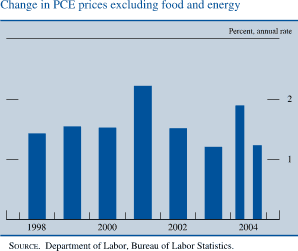
The price index for GDP was less affected by last year's rise in energy prices than was the PCE measure; much of the energy price increase was attributable to the higher prices of imported oil, which are excluded from GDP because they are not part of domestic production. GDP prices increased 2-1/2 percent last year, 3/4 percentage point faster than in 2003. In addition to the rise in PCE prices (excluding the influence of imported oil), GDP prices were affected by a sizable increase in construction prices for residential and nonresidential structures.
